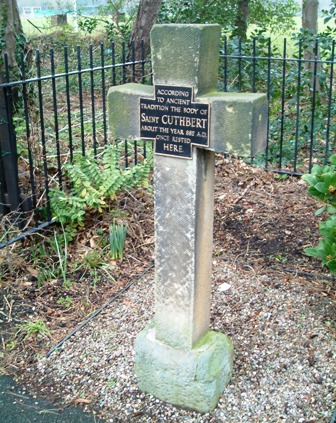The Monks of Lindisfarne arriving at Lytham
Newspaper cutting dated 1889
ST. CUTHBERT AT LYTHAM : A LEGEND.
" The Monks of Lindisfarne arriving at Lytham with the body of
St. Cuthbert, A.D. 878," is the title of a large picture at present on view in Fishergate, Preston.
It is one of a series the Very Rev Monsignor Gradwell has commissioned Mr Charles E. Turner, of
Walton, to paint illustrating the early history of Christianity in Lancashire. The series is
intended by the Very Rev Monsignor for St. Joseph's seminary, Upholland. The following extracts
from an article by Mgr. Gradwell, in " Merriy England." October, 1889, will explain the incidents
leading up to the event Mr Turner has been called upon to depict :
" In 875 Halfdene invaded Bernicia, the northern portion of Northumbria, . . . Lindisfarne was no
longer a safe place for the monks, and they dared no longer expose their great treasure, the relics
of St. Cuthbert, to the ruthless impiety of the northern hordes, With their Bishop Eardulf they set
out on a weary pilgrimage of seven years.


… From Yorkshire they proceeded to Lancashire, and as we find that the holy
relics rested at Mellor, near Blackburn, we may suppose they would journey through Ribblesdale,
passing on their way the ruined city of Bolmetonacae, the modern Ribchester. They were a numerous
company, for besides the venerable Bishop Eardulf there were the Abbot of Carlisle, the monks of
Lindisfarne, and many of the natives of that island. In going to Lytham it is probable the party
would pass through Preston, where a few houses had gathered about the church built in honour of St.
Wilfrid, the great contemporary of St. Cuthbert.
Their way from Preston to Lytham lay through a country abounding in forest and fen. But they would
have the advantage of the old Roman road as far as Kirkham. However, the pilgrims met with a
hospitable reception, and to this day Lytham is the seaside home of St. Cuthbert on our western
coast."
Mr Turner's picture gives the long procession of monks and the others who followed them winding
amongst the sandhills above the beach at Lytham, with a few of the fisher folk as onlookers.
A modern cross placed in an old socket near St.Cuthbert's Church,
Lytham. The plaque reads: According to ancient tradition the body of st.Cuthbert about the year 882
A.D. once rested here.
|